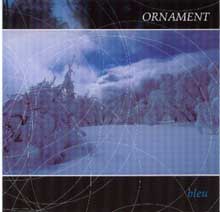Ornament
 |
|
|
Ornament is collaboration between artists Joe Creighton & Simon Polinski.
Previous works of these artists yielded Creighton's classic album "Holywell" and more recently "Falling Again" & Polinski's "Hesius
Dome" - The Age of Steam.
There is no doubt about the pedigree of talent these two have to offer as is evident in their backgrounds.
Joe Creighton - Bass Player and vocalist for artists such as Black Sorrows, Kylie Minogue, John Farnham, Olivia Newton-John, Lee Kernaghan, Tania Kernaghan, Kate Ceberano, Boz Scaggs, Ray Charles and more recently with his own band "The Revelators" with James Black & Joe Camilleri.
Simon Polinski - as composer, engineer, producer and bass player for artists such as The Church, Paul Kelly, Ollie Olsen, Tim Finn, Yothu Yindi, George Telek and with music scores such as In a Savage Land, Idiot Box and most recently The Man Who Sued God.
Their first release together has heralded "Elgarhythms" which is on the compilation album "Zen Connection"
As critiqued by Alex Reed, Director A&R, Taxi America.
.. ' I see Ornament fulfilling a need by adult music lovers who don't feel like going to a Rave but want more edge than is found in New Age Music"
The track 'the jesse tree' was named after my son, here is some information on the origin of the name Jesse and the Jesse Tree:
the jesse tree
Sometimes called the root of Jesse or radix Jesse in Latin, the Jesse tree is a visual representation of Jesus' genealogy which dates back to the father of David who was Jesse.
The biblical references used habitually to establish Christ's descent from David are the following:
Isaiah 6,14; 11,1; 53,2
Num 24,17
Mat 1,1-16
Lk 3,23-38
Rev 22,16
In sacred art Mary is also depicted as part of Christ's family tree named after Jesse.
The Fathers of the Church and Latin hymns refer to the tree of Jesse not only whenspeakingabout the line of David (radix Jesse) but also when speaking of Mary (virga exradice = branch or offshoot of the root of Jesse) and Jesus (flos ex virga = flower that blossoms on the branch).
Based on these literary sources, the visual rendering of the Jesse treeshows Jesse in reclined and slumbering position, a tree growing out of his body on whosebranches a changing and diverse group of ancestors can be observed.
The tree which is patterned after the tree of life in paradise and the cross as the definitive tree of life habitually shows a series of kings of the Solomonic line, or prophets and evangelists. The top of the tree is composed of Mary, Jesus and angels, sometimes with reference to the giftsof the Spirit. But variations are frequent. The artistic motif of the Jesse tree is known beginning in the 11th century and seems to have disappeared in the 16th century.
During the time of bloom it found many and diversified ways of realization from illuminations to bronze doors (for example,St. Zeno, Verona).
The example here presented is taken from a psalter of the 13th century, the so-called Ingeborg Psalter (1210) conserved today in Chantilly, Paris.
The tree is highly stylized and of sophisticated ornamentation. Jesse is lying on his bedmore pensive than slumbering. He wears the typical Jewish hat. From the mid-section of his body or rather behind it, the trunk of the tree rises to a height of four levels or tiers each once of them in the shape of a chalice.They show in ascending order [from left to right] Abraham, David, Mary and Jesus Christ. It is the royal line. For this reason all figures except Christ wear crowns.